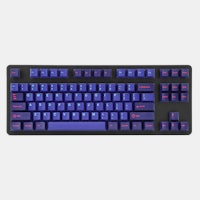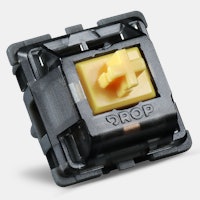Click to view our Accessibility Statement or contact us with accessibility-related questions















Massdrop 101: Intro to Keycaps

search
close
Sort by: Newest
keyboard_arrow_downKangTheMad
127
Jun 7, 2016
This is really cool. So far, I've only used OEM keycaps, but I'll have a set of cherry profile arriving soon, and then in November I'll have that jukebox set (although I may end up getting something else before then). I'd really like to get some artisans at some point but all the ones I like are just blank and simple, and usually when I see them they're either bought up immediately, or are priced so high that I couldn't afford them. I've seen a few raffles and one day I hope I'll win one =) or that massdrop will do a drop of one that I actually like. I don't care for the figurine-esque ones of Darth Vader and Yoda. If some people like that then that's fine, but it's just not for me. I'd like to see a drop of just some "plain" artisans that are colorful but not molded into anything crazy; just normal keycap shapes.
PurpleSweetTart
2
Jun 7, 2016
can I but a Mac compatible mechanical keyboard and change switches and keycaps without a soldering iron? I cannot build my own mechanical keyboard from the ground up as I am physically disabled with impaired hand-coordination and cannot use heated tools because I would surely burn myself. I am dying for very loud click switches (Cherry Blue or equivalent) with tactile feedback, because I am a child of the 80's and miss click keys so much. I would like to have a different 3D printed cap for each key because I have to look down at my keyboard to use it and can only type with my thumb and index finger, but if I had a different cap for each key, I might be able to learn which key is which and maybe not have to watch my keyboard. I prefer a keyboard without a keypad because I have the Apple Wireless. Can you give any advice about which keyboard I should choose to modify? I don't have access to a 3D printer but I would pay for custom keycaps that would suit my needs. Thanks for any help you can give!

Makami
4255
Jun 7, 2016
PurpleSweetTartHello,
the best way might be to look for a fully Mac compatible mk with blue switches or, if you like more force needed, green switches from cherry or gateron first.
This way the need for (de)soldering wouldn't occur at all, for the full compatiblity others have to speak up, i only use linux and windows.
There are certain mks from time to time that would allow switchmodding without (de)soldering, but i have no idea if you would be able to open up the switches (top and bottom half) for exchanging stems and springs.
Then we've diy-kits (do it yourself) from time to time, where it would be needed to find someone, local or communitywise, for soldering service.
If this is set, the next step might be to get caps you like, but your wish of different 3D printed caps for each key would be very expensive and not even be possible for all caps.
Hope this helps to get things started.
Edit: To change keycaps no soldering needed.
the best way might be to look for a fully Mac compatible mk with blue switches or, if you like more force needed, green switches from cherry or gateron first.
This way the need for (de)soldering wouldn't occur at all, for the full compatiblity others have to speak up, i only use linux and windows.
There are certain mks from time to time that would allow switchmodding without (de)soldering, but i have no idea if you would be able to open up the switches (top and bottom half) for exchanging stems and springs.
Then we've diy-kits (do it yourself) from time to time, where it would be needed to find someone, local or communitywise, for soldering service.
If this is set, the next step might be to get caps you like, but your wish of different 3D printed caps for each key would be very expensive and not even be possible for all caps.
Hope this helps to get things started.
Edit: To change keycaps no soldering needed.

AlexPk
7198
Community
Jun 7, 2016
PurpleSweetTartThis might be right up your alley: http://matias.ca/minitactilepro/mac/
Comes in Matias clicky. Very satisfying.
Comes in Matias clicky. Very satisfying.

BrainFlush
6856
Jun 7, 2016
This should be posted at the bottom of every product sold on MD that's keyboard related.
It will help new people and curious people and maybe those that frown on us for spending so much on stuff. And make sure to add part 2 at the bottom.

AlexPk
7198
Community
Jun 7, 2016
BrainFlushOnce we open it up to 100% of the site I think this would be a great idea

BrainFlush
6856
Jun 8, 2016
AlexPkIt's what it should be, naivety can be countered.
You guys would be doing us fans a great service by linking it.

drakeonyou
198
Jun 6, 2016
I cry every time I see the Danger Zone SA's. I wish I was part of that drop.
Is there a shine-through SA key set?
Is there a shine-through SA key set?
Showing 20 of 23
PRODUCTS YOU MAY LIKE
Trending Posts in Mechanical Keyboards
The-Cindy
This is easily my new favorite keeb
The IDOBAO ID80 Crystal Gasket Keyboard Kit is a standout choice for mechanical keyboard enthusiasts seeking both aesthetics and performance. Its transparent acrylic case beautifully showcases the...
Dec 20, 2024
Squizzle
Keyboard & Drink
Shine-Through LOTR Keycaps Concept
Would anyone else be interested in a shine-through set of LOTR keycaps? Imagine a glowing black speech keycap set that seduces like the one ring. Perhaps the pale blue moonlight glow of the elven...
Dec 20, 2024
Akofena
Are shipments to Argentina safe?
I want to buy a keyboard with some keycaps ! but i live in argentina. ty
Dec 17, 2024

tbui
Absolutely stunning
The colors really pop on a white board. Easily one of the best caps I own!
Dec 17, 2024
bobbibeer1976
False Advertising BEWARE
This company should be ashamed of themselves. Advertising to young people who save all their money and want nothing more than a keyboard and advertise to them that it is in stock and will be shipped asap and they will arrive before Christmas. Only to "ship" and package and get their hopes up and it arrives and there is no keyboard in the package. Then to get on the website and it isn't even going to ship until January. This happens AFTER you have received their money and made promises that it was arriving, on it 's way, etc! Shame Shame on you!!!
Dec 16, 2024

EuclideanGambit
Closest profile to MT3
I really enjoy the MT3 profile, it has actually become kind of difficult to type on other profiles. So I was looking for some that might be close and noticed the SA profile. I was wondering if there were anymore that were close to it. This would open my options significantly when shopping around.
Dec 15, 2024

tbui
Displaying my DCD Lunar New Year set (Max)
Enough for a full base kit plus novelties, just gotta watch the ample space on top when moving/tilting and near the edges it gets tight so the caps don't fit in as smoothly.
Dec 15, 2024






















Keycaps: What Are They?
Think of keycaps—the things you touch with your fingers when typing—as the clothes that tie a keyboard together. Without them, a keyboard is naked. With them, a keyboard takes on a personality of its own. That’s because keycaps have become much more than the plain-Jane, off-white, basic pieces of plastic from keyboards past.
Now, there are keycaps in every shape and color imaginable, plus a variety of different textures. Some are glistening gold. Others fade from light to dark. Some are perfectly round, and others are shaped like everyday objects. There are even keycaps that look like characters from comic books and movies. Indeed, like clothing, keycaps are a form of self-expression. What do your keycaps say about you?
Keycaps: What Are They Made Of?
Most keycaps are made by injection molding thermoplastic. The process involves melting plastic and injecting it under pressure into a steel mold. The most common types of plastic are ABS and PBT.
ABS plastic, short for "acrylonitrile butadiene styrene," is the most commonly used plastic, mainly because the material is less expensive and easier to work with.
Legends are the letters, numbers, or symbols printed on the keycaps—the markings that tell you which character will appear on your screen when you touch that key. Just as customizable as the color of the keycap, the legend can be printed in a variety of fonts, colors, and sizes. It can be printed on the top, front, or side of the keycap, or it can be absent from the keycap entirely.
There are a few different ways to mark a keycap with a legend, including pad printing, dye sublimation, laser etching, and double-shot molding. There are also a few other methods, such as UV printing, but these are less often used.
Pad printing is the most commonly used method, and for good reason: It’s fast and cheap. But pad-printed legends—made by dipping a pad into ink, then transferring it onto the keycap—are quick to fade and are therefore less desirable.
Laser etching is exactly what it sounds like: A laser beam is used to burn the legend into the keycap. Though it does a good job of creating lines, it has a harder time creating solid-fill legends, like the one on the Windows key. Laser-etched legends are also quick to collect dirt.
Dye sublimation uses heat to impregnate the keycap with dye. The dye actually becomes part of the plastic keycap, ensuring the legend will never fade like pad-printed legends do. Dye-sublimated keycaps are among the most desirable.
Double-shot molding is another one of the most sought-after methods of keycap printing. As its name implies, double-shot molding is a two-step process, and it results in a couple of different benefits. For one, legends will never fade from double-shot keycaps. They’re also bolder and more vibrant, and they can be colored a distinctive hue different from the keycap itself. What’s more, a keycap with a double-shot legend is uniformly smooth—no raised or indented textures.
Keycap Mounts & Compatibility
Not all keycaps work with all keyboards. Turn the keycap over and you’ll see the mount. This is the attachment point between the keycap and the key switch. Because different types of switches feature different types of stem shapes, you’ll have to be sure the keycaps you use are compatible with the switches on your board. Cherry keycaps, for example, will not fit on Topre boards unless you’ve added a slider to the switch. Stay tuned for more on sliders in future articles!
To switch out your keycaps, you’ll need a keycap puller. Most of these basic-but-handy tools consist of two pieces of wire and a handle. Slip the two pieces of wire beneath each side of the key and pull. Voila. You’re ready to switch out your keycap.
This article touches on the basics of keycaps—plenty to get you started on your first set. But there are a lot of nuances, such as keycap profile, that we’ll cover in future tutorials. Until then, as you explore the wide world of keycaps and the Mech Keys Community at large, remember that it’s all about customizing the keyboard to your liking. There’s no good or bad, right or wrong keycap. The keycaps you choose should feel and look good to you—nobody else. Because that’s what mechanical keyboards are all about: a better user experience.
Hit the "Follow" button to get notified about future articles from this account.